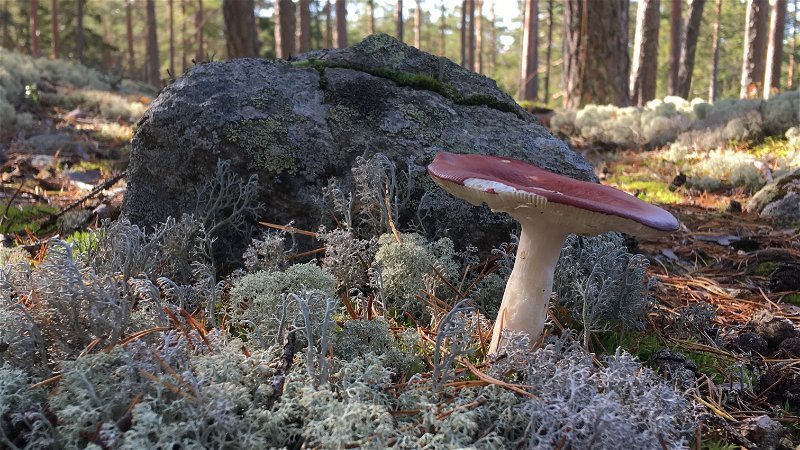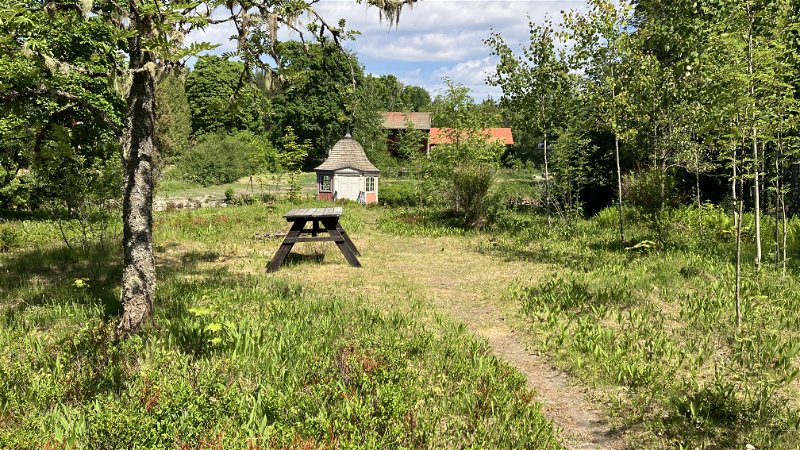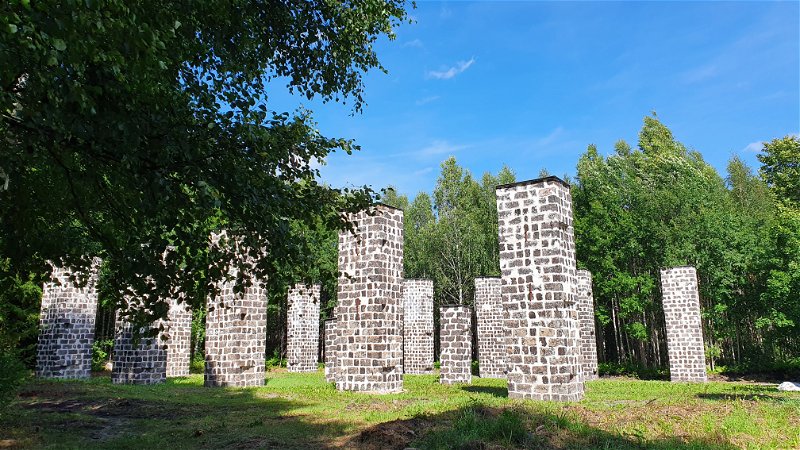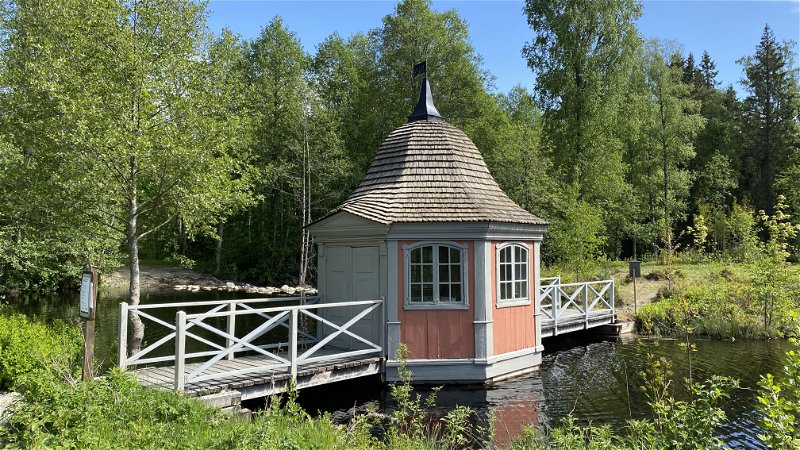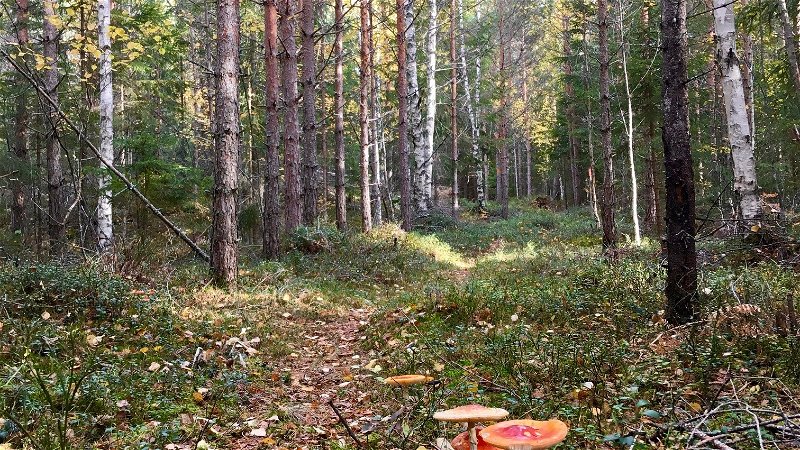The first part of stage no. 16 goes over boulder-rich terrain through small hills. The second half you walk along first a gravel road and then a small country road.
You leave the exciting and historic place Trummelsberg behind you and turn off into the forest. At first, the trail goes along a hill where you can glimpse the lake Dammen between the pines. At the far end of the lake, you come right down to the water, where you can take a dip.
The terrain now slopes gently upwards. After passing over moss- and heather-covered woodland with large boulders and low pine forest, you arrive at a small steep hill. The hill takes you up Ormkärrsberget You walk over fine rocks and soon arrive at a place with magnificent views of the forested landscape around.
From the viewpoint it slopes down again and the forest becomes denser. Soon you come out on a dirt road that you follow for about 3 km. The road is surrounded by forest on both sides. Along the way you pass a quarry where high quality gneiss is mined. The operation started with test quarries in 2002. The stone is processed into floor tiles and facades, among other things. From the quarry you have a beautiful view of the Great Chain.
When you arrive at the Bockhammar stage destination, you will be greeted by small red cottages in an old mill environment. Here you can visit Ebba Brahe's gazebo and have a coffee at the café next door. A short distance from the road is the windbreak.
RESTING PLACES
At Trummelsberg there is a cozy campsite down by Lake Stora Kedjen. Here you will find a shelter, 2 fireplaces, tables and benches, TC and swimming area with jetty. There are large grass areas to pitch tents on.
At the stage destination Bockhammar there is a shelter on a hill in the deciduous forest a short distance from the road. TC is adjacent to the shelter. The terrain is poorly suited to camping.
TRUMMELSBERG
Five kilometers into the forest, west of road 66, Trummelsberg is located by Lake Stora Kedjen. Of this mill, founded by Olof Trummel in 1622, only ruins remain today. The ore came here from Norberg and the finished ingot or bar iron was then taken to Färna mill. The hammer mill was closed down in 1864, while the smelter continued to operate until 1907. Nature has now reclaimed most of the site, but traces of the busy mill operations remain. Visitors to the site can see the remains of the roasting furnace, the large gray stone pillars that were once a coal house, the dug canal, traces of the quay where the barges that carried the pig iron docked, and some residential buildings from the 19th century.
BOCKHAMMAR
Bockhammar is also an old mill area. A mill was established here in 1607 and its history is closely linked to Ebba Brahe. She was the owner of the mill for a long time, which she inherited from her father Magnus Brahe.
There were three hammers with five hearths at Bockhammar's mill, and for a time there was also a smelter. In 1770 Bockhammar was incorporated into Färna mill. Just over a hundred years later, the operation was closed down.
Today, all that remains is a timber-framed farmhouse from 1817 and, the most famous building in Bockhammar, Ebba Brahe's gazebo. The gazebo is beautifully situated down by the river. On the roof is a wind vane where you can read the text "Ebba Brahe's pavilion".
EBBA BRAHE'S GAZEBO
Ebba Brahe's rose-painted gazebo is located on a small island in the mill pond at Bockhammar. According to the wind vane on the roof, the gazebo was built in 1636, making it the oldest in the country. Inside there are beautiful decorative paintings.
Ebba Brahe was a countess. At the age of 15, she became a lady-in-waiting to the newly widowed Queen Christina. Kristina's husband, King Karl IX, was succeeded by their son Gustav (II) Adolf, who was then 17 years old. King Gustav Adolf soon fell in love with the beautiful Ebba Brahe. Their relationship can be partly followed through a preserved correspondence. In 1613, the king wrote a letter containing a formal proposal.
Queen Dowager Christina opposed the love affair for political reasons. She wanted to see the king married to a German princess. Her stubborn opposition persuaded Gustav Adolf to renounce love. In 1615, he went into battle and that was the end of the romantic relationship. Three years later, Ebba Brahe married the count and commander Jakob De la Gardie. They had a long marriage and Ebba became the mother of no less than 14 children. One of them was Magnus Gabriel De la Gardie. King Gustav Adolf married Maria
Eleonora of Brandenburg. When the king died in 1632, their only child, daughter Kristina, was 5 years old.
LIVING AND EATING
At Bockhammar there is a café that serves coffee and homemade bread. The café is open during the summer and well into the fall.
In Bockhammar there is also the possibility of accommodation at Stallkarlsgården.
READ MORE
Directions
You cannot get to Bockhammar or Trummelsberg by public transport.
You can park a few cars at Trummelsberg.

